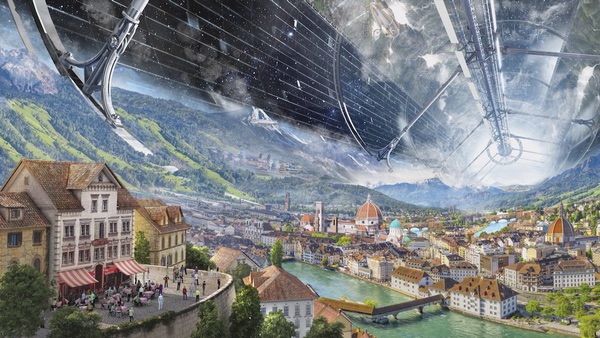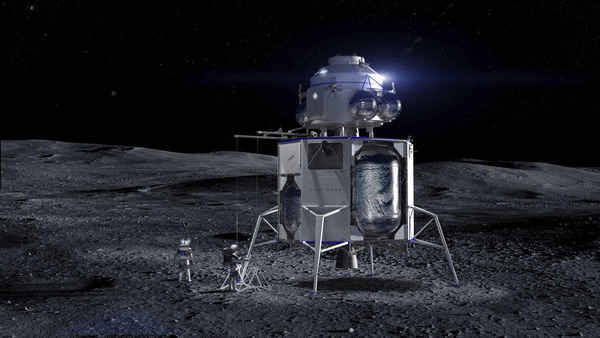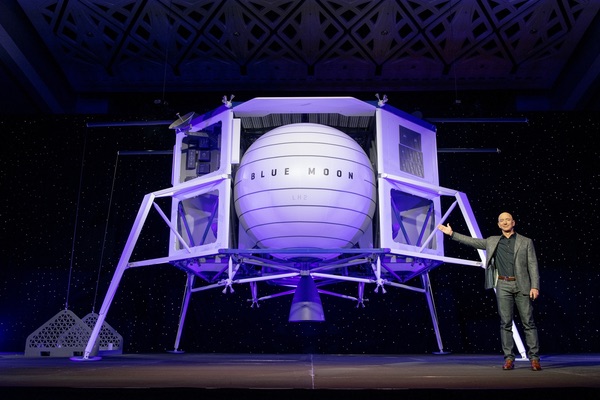Blue Moon and the infrastructure of space settlementby Jeff Foust
|
| “For all of human history, the Earth has felt big to us,” he said. “That’s not true anymore. The Earth is no longer big. Humanity is big.” |
The company hinted at the announcement in a cryptic tweet: a photo of Endurance, Ernest Shackleton’s ship, in the Antarctic ice, along with a date: “5.9.19.” Given that Shackleton is also the name of a crater at the south pole of the Moon, one which may harbor deposits of water ice, many surmised that update might include something about the Blue Moon lunar lander concept the company announced two years ago, especially given the desire of the Trump Administration to accelerate a human lunar landing.
The guests who trickled into the ballroom were greeted by blue lighting, starscapes on the walls, and a stage in the middle of the ballroom, with a large curtain hung across it. Much of the ballroom was behind that curtain, suggesting that there was something back there to show off at some point.
On hand for the event was a wide spectrum of space professionals and others. Apollo 17 astronaut Jack Schmitt was there, as was Mark Sirangelo, who joined NASA as a special assistant to the administrator last month to support its revised exploration campaign. There were officials from space-related companies and organizations, representatives of the DC offices of other national space agencies, and planetary scientists like Lindy Elkins-Tanton and Steve Squyres. A group of schoolchildren, wearing matching blue shirts, filed in and sat on couches near the front of the stage. The attendees also included actor Cas Anvar, best known as one of the stars of the sci-fi series “The Expanse” that was saved from cancellation by Bezos last year; he said later he came because of his interest in finding ways to balance technology with humanity.
Shortly after 4 pm, the event started with a video about the Apollo 11 landing, and then Bezos took the stage. “If that does not inspire you, you are at the wrong event,” he said of the video.
If Bezos was going to unveil a lander, he wasn’t going to do it right off the bat. Instead, he spent more than 20 minutes outlining his vision for humanity in space, and using space to solve the problems on Earth. He has done so on a number of occasions in the past, such as an on-stage interview at the International Space Development Conference nearly a year ago (see “Bezos and humanity’s future beyond Earth”, The Space Review, June 4, 2018). But he used this appearance to describe his views in greater detail.
“For all of human history, the Earth has felt big to us. And, actually, in a really correct sense, it has been big. Humanity has been small,” he said. “That’s not true anymore. The Earth is no longer big. Humanity is big.”
The Earth’s resources are finite, he said. And, while addressing “immediate problems” like poverty and the environment, “there are also long-range problems, and we need to work on those too, and they take a long time to solve.” An example of such long-range problems, he said, is access to energy: while terrestrial solar power offers one solution now for providing clean energy, at current rates of growth in energy usage, the entire surface of the Earth would need to be covered in solar cells in a couple hundred years. “That’s not going to happen.”
As he argued in the past, that looming scarcity of energy and other resources presents two choices. “What happens when unlimited demand meets finite resources? The answer is incredibly simple: rationing,” he said. “It would lead, for the first time, to where your grandchildren and their grandchildren would have worse lives than you. That’s a bad path.”
The alternative path, as you’d expect, involves space. “If we move out into the solar system, for all practical purposes, we have unlimited resources,” he said. “So, we get to choose: do we want stasis and rationing, or do we want dynamism and growth? This is an easy choice. We know what we want, we just have to get busy.”
 One of the illustrations of space colonies Bezos showed in his presentation. (credit: Blue Origin) |
From there, he touched upon the concepts of space colonies espoused more than 40 years ago by the late Gerard K. O’Neill, eschewing the “planetary chauvinism” of trying to settle places like Mars in favor of creating our own habitats near the Earth. That included showing off some new illustrations of those concepts, updated versions of the famous 1970s-era depictions. “These are beautiful,” he said. “People are going to want to live here.”
| “These are beautiful,” Bezos said of illustrations of space colonies. “People are going to want to live here.” |
Those space settlements, he acknowledged, are not a near-term prospect. “Who is going to do this work? Not me,” he said. “The kids in the front rows, you guys are going to do this, and your children are going to do this. This is going to take a long time. This is a big vision.” (Later in the speech, to help promote that vision, he announced the formation of a new organization, Club for the Future, which its website describes says will “connect young people who love our home planet, who believe in the power of human ingenuity and the abundance of space, and who are unshakably optimistic about the future.”)
That vision, he said, requires enabling infrastructure, including vehicles that can provide low-cost access to space to make new space industries possible. “My generation’s job is to build the infrastructure,” he said. “We’re going to build a road to space, and then amazing things will happen.”
Blue Moon, updated
That infrastructure includes the launch vehicles his company is developing. He talked briefly about both the New Shepard suborbital vehicle, which flew its latest test flight one week earlier, and the New Glenn orbital launch vehicle under development. He offered little in the way of news about either, confirming that the company planned to start flying people on New Shepard by the end of this year.
“Woohoo!” someone in the audience shouted after Bezos talked about flying people on the vehicle.
Such vehicles are just part of the infrastructure that he envisions. Another, he said, is that which enables use of in-space resources. “We were given a gift: this nearby body called the Moon,” he said.
Using those resources, like water ice, requires accessing the Moon. “The Moon also needs infrastructure,” he said. “Let me show you something.”
With that, the curtain went up. And, sure enough, there was a lunar lander—or, at least, a full-sized mockup of a lunar lander. It was Blue Moon; specifically, an updated version of the lander concept the company had started discussing more than two years ago.
| “I love this. It’s the right thing to do,” Bezos said of the 2024 lunar landing goal. “We can help meet that timeline, but only because we started three years ago.” |
This version of Blue Moon is capable of placing 3.6 metric tons of payload on the surface of the moon, while a “stretch tank” version with larger tanks could carry 6.5 metric tons to the surface. That payload would be placed on a deck on top of the lander, and lowered to the surface using a davit, a crane system Bezos said was inspired from those used on naval vessels.
The lander will use terrain relative navigation to enable precise landings, Bezos explained as he took the audience on a tour around the mockup. An optical communications system will provide gigabit data rates back to Earth, with X-band radio as a backup.
The mockup was dominated by a large tank that will hold liquid hydrogen. That, and a smaller tank for liquid oxygen, will hold the propellants for the lander’s new engine, designated BE-7. That engine, producing 10,000 pounds-force (44,000 newtons) of thrust, is under development by Blue Origin, with a first test firing this summer.
The choice of liquid hydrogen and liquid oxygen was driven in part by lunar resources, Bezos said. “Ultimately, we’re going to be able to get hydrogen from that water on the Moon, and be able to refuel these vehicles on the surface of the Moon,” he said. Besides powering the BE-7, boiloff from the liquid hydrogen tank will be used to help cool the liquid oxygen tank, and also go into a fuel cell that produces electrical power. The lander uses fuel cells rather than solar panels, he noted, so that it can operate through the two-week lunar night.
 A version of Blue Moon equipped with an ascent module capable of supporting human missions ot the lunar surface. (credit: Blue Origin) |
The rollout of the mockup, though, was short of other details about the lander, including just how far along in its development it is. Bezos said Blue Origin has been working on the lander for three years, but beyond noting that the BE-7 would soon begin testing, said little else about the maturity of the design.
A company official, speaking on background after the event, said that the design for Blue Moon had gone through several design iterations. That including maturing the requirements of the lander and working through a preliminary design.
Some of that work is being supported by NASA. Blue Origin won two “Tipping Point” technology development awards from NASA last year for technologies the agency said “have the potential to significantly benefit the commercial space economy and future NASA missions.” One award is to test cryogenic fluid management technologies, and the other is for terrain relative navigation. Blue Origin plans to test both on its New Shepard suborbital vehicle next year.
NASA’s accelerated timeline for a lunar return, though, has changed some of the company’s plans. The company official said Blue Origin originally considered a very methodical approach to Blue Moon, demonstrating the cargo lander’s capabilities and then introducing the stretched version with more capacity. That stretched version, though, may be accelerated so that it can accommodate an ascent stage that could transport astronaut to, and then back from, the lunar surface.
| “What I’m laying out here today is obviously a multi-generation vision. This is not going to get done by any one generation.” |
Bezos alluded to a crewed ascent stage in his presentation, and illustrations released by the company show that stretched version of Blue Moon, with an ascent stage on top, on the lunar surface along with a couple astronauts. The company does have designs for an ascent stage, but didn’t go into details about them.
Bezos made clear, though, that he supported the new goal announced by Vice President Mike Pence in a speech in March calling for a human lunar landing by 2024. “I love this. It’s the right thing to do,” he said. “We can help meet that timeline, but only because we started three years ago.”
The company believes that Blue Moon could be ready for a first mission to the Moon, testing the descent stage only in 2023. That would be followed by a 2024 flight of the stretched version with an ascent lander, without astronauts, as a dress rehearsal for a crewed mission. If that flight goes as planned, a crewed lunar landing mission could take place before the end of 2024.
That timeline, though, depends on NASA’s plans and funding. The agency said last month it will issue a call for proposals, likely by the end of this month, for integrated lunar lander systems, rather than procure ascent and descent stages, and transfer vehicle for moving them in lunar orbit, separately. Blue Origin, which submitted a proposal earlier this year for NASA studies on descent stages, would likely participate in the new competition.
But if this lunar initiative goes by the wayside as previous efforts have, or if Blue Origin doesn’t win a NASA competition for a lunar lander, it’s not clear what will happen next with Blue Moon. Bezos’ vision suggests that it will need to develop one, sooner or later, to provide that infrastructure he says is needed to tap the resources of the solar system, but with his long-term mindset, it might be later rather than sooner.
“What I’m laying out here today is obviously a multi-generation vision. This is not going to get done by any one generation,” he said near the end of the presentation. “If this generation builds the road, builds that infrastructure, we will get to see thousands of future entrepreneurs building a real space industry.”
Note: we are temporarily moderating all comments subcommitted to deal with a surge in spam.
